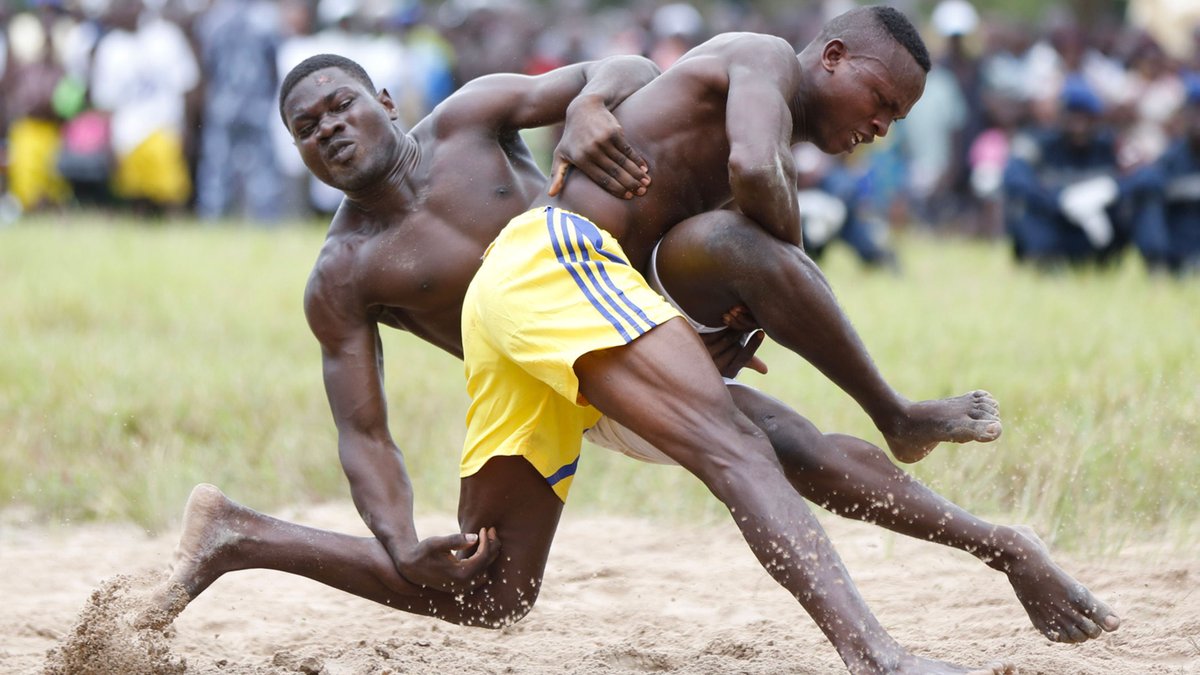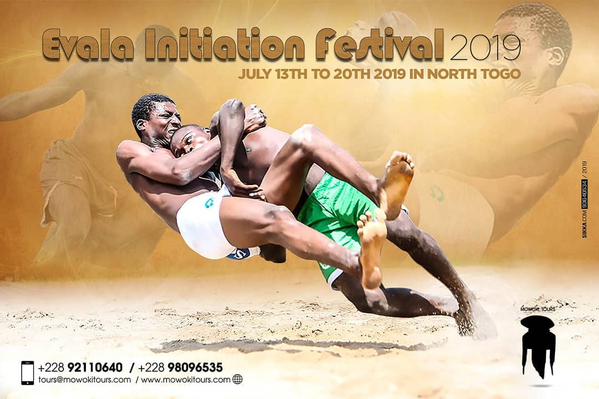
Evala (Togo)
- Name of sport (game): Evala
- Place of practice (continent, state, nation):
Togo
Initially practiced in the nine Kabyè districts, the evala wrestling has crossed the borders of the Kozah province. The Yaka district in the Doufelgou province also practices it now, not to mention at least 13 other districts — Lama, Pya, Tchitchao, Yadè, Bohou, Kouméa, Sarakawa, Landa, Djamdè, Yaka, Tcharè, Soumdina and Lassa.
- History:
The most important initiation ritual in the Kabyè society is played by the Evala, a ritual fight, a kind of wrestling, that marks the passage of young males to the stage of maturity.
In the past, the fights, that could last for several hours, were practiced using a chicotte, that is a kind of riding crop and a stick, with these two objects the adversaries would face each other hitting each other until one of them failed , exhausted by the blows received.
When he fell, the alleged winner rushed over him and sat on his chest, only at that moment the referee declared the end of the game and its winner.
This system of fight matches began to resolve inter-tribal conflicts, so the fight replaced the war between tribes; today, however, the organization of ritual fights also has a more festive aspect and, at each celebration, a magnificent spectacle is created.
The Evala is an initiation rite, the penultimate of rites in the life of a man, it is certainly the most important and, to prepare for this event, young people are separated from their families for a week, living in special huts, where they are fed and are mentally prepared.
Young people also face a preparation that involves numerous sacrifices that the adolescent must accept: fasting, sexual abstinence and scarification. - Description:
Before starting wrestling, participants must make a pilgrimage, that consists of climbing three mountains; those who do not complete the pilgrimage will be initiated into adulthood.
Before the match each competing family performs some ancestral worship rituals, invoke the spirits of the ancestors who dwell in the clay statues placed in the courtyard of the housing complexes, each statue represents an ancestor.
The elder of the family speaks with the clay statues as if he was talking to a member of the living family, invokes the ancestors who live in the clay, and pours a libation as an offering.
The sacrifice is part of the ceremony and the numerous feathers that cover the clay statues are the result of these repeated acts of worship.
For large events such as the Evala, the clay statues are carefully and respectfully removed from their niches to be worshiped; if a white rooster flaps its wings, people believe it is a benevolent sign of the ancestors.
The women prepare a local dish, based on yam and manioc, that will be served to the wrestlers after the match.
There are offers of libations to the ancestors, together with a bowl of corn wine, so that they can help and protect the family, this is a very solemn moment of the entire ceremony.
At this point the actual ceremony can begin, the main purpose of this ritual is to make the young man hard, brave and stoic and consecrate not only the transition from adolescence to adulthood, but also the affirmation of his Kabyè cultural identity.
The consumption of dog meat is a central and essential element of the Evala ritual, for the aspiring Evalou, this consumption is not a choice but rather a prescription necessary for the fulfillment of the initiation rites, the initiate is forced to consume dog meat to acquire the qualities of this animal: resistance, tenacity, strength and intelligence.
A teenager has to fight for three consecutive years, starting from the age of 18, before he can be considered a man, the fights involve two teams composed of 4 or 5 wrestlers who face bare-chested, under the eyes of their parents, friends and onlookers who encourage them with songs, shouts and sounds of horns.
The wrestlers are sprinkled with white powder, a symbol of value, and fight until sunset, giving their best, whether or not he wins, the tribe recognizes the initiate as a man, a young man who has never fought is not considered an adult, especially not among his peers.
After several stages of confrontation between the teams, the winners can be proclaimed according to the number of victories, the presence of wise men of the community ensures respect for the rules, and the arbitration of the fights, also reveals the strong traditional aspect of the ceremony.
Successful wrestlers are invited to the chief's house to wear their red berets; men with red berets are called "warriors", ie the best of all fighters.
The Red Cap dance is considered a symbol of maturity and courage in the men's initiation ceremony.
At the end of the Evala, the traditional priests and the feticheur make a tour of the sacred places, above all the sanctuaries that are found in the forests and in the caves, to thank the ancestors for allowing a good performance of the initiation rites.
At the end of the Evala rites, the young man takes a new social status with rights but also obligations including: the right to exploit the land on his own, to marry, to defend the village in case of aggression.
The Kondona, are ceremonies that begin the day after the closing of the Evala, the young initiate, who has completed his three years of fight, becomes an Ezoukpo, a sort of middle class and can aspire to become a Kondo or adult. - Current status:
Practiced

- Importance (for practitioners, communities etc.):
Evala is the very first introduction to the human life of the teenager Kabiye. Before being subjected to these rites, young people have long been prepared psychologically and physically. In Kabyè country, a young person who shies away from this initiation suffers reprisals from the wise men, his parents and the whole of society. He's sort of excluded from the community.
The primary purpose of this operation is to accustom the young person to endurance, courage and stoicism. The cultural aspect of the event is heightened by the sacrifices that the teenager must make: fasting, sexual abstinence and the scarifications which are the outward signs of the warrior.
The traditional aspect of the ceremony is revealed by the presence of the elders of the community. It is these wise men who ensure compliance with the rules, ensuring the management and arbitration of tournaments. The dates on which the ceremonies are held are fixed by the consultation of the oracles followed by the authorization granted by the high priest called "Tchodjo". After the struggles, traditional priests tour sacred places to thank the ancestors for allowing the ceremony.
https://touchstamps.com/Stamp/Details/638523/lutte-des-evala - Sources of information :
Articles:
https://www.myafricanmagazine.com/initiation-wrestling-in-togo/
https://www.exploring-africa.com/en/ethnic-groups/kabye/kabye-male-rites-evala-fight-and-kondona
https://togopresse.tg/les-luttes-evala-2023-demarrent-samedi-dans-la-kozah/Video:
https://www.youtube.com/watch?v=gp-Lc60horQ
https://www.youtube.com/watch?v=7qb1e-rf_-U
https://www.youtube.com/watch?v=ovFosTqmKpA
https://www.youtube.com/watch?v=GWNu6lVkUn8The information contained in the article comes from the following sources:
https://www.exploring-africa.com/en/ethnic-groups/kabye/kabye-male-rites-evala-fight-and-kondonaSource of photos used in this article and gallery:
https://www.republicoftogo.com/toutes-les-rubriques/societe/luttes-masquees
https://lavoixdelanation.info/togo-demarrage-de-ledition-2018-luttes-traditionnelles-evala-pays-kabye/
https://lavoixdelanation.info/togo-debut-de-ledition-2019-des-luttes-traditionnelles-en-pays-kabye/
https://twitter.com/republicoftogo/status/1182698071316226049
https://lomeactu.com/evala-5-raisons-fete-traditionnelle/
https://togopresse.tg/les-luttes-evala-2023-demarrent-samedi-dans-la-kozah/
https://www.savoirnews.tg/blog/2022/07/11/evala-2022-poursuite-des-luttes-lundi-dans-la-kozah-la-finale-dans-le-canton-de-tchitchao/
https://lavoixdelanation.info/togo-demarrage-des-luttes-traditionnelles-en-pays-kabye/
https://togoweb.net/togo-le-calendrier-pour-les-evalas-devoile/news/
https://www.koaci.com/article/2023/07/08/togo/culture/togo-debut-des-festivites-de-la-lutte-evala-2023_170688.html
https://lomeactu.com/togo-clap-de-fin-pour-le-tournoi-de-lutte-traditionnelle-evala/
https://icilome.com/2023/07/togo-evala-quelques-cliches-des-empoignades-a-kara/
https://toplist.info/top-list/most-famous-festivals-in-togo-4694.htm
https://news.piaafrica.com/togo-tribune/togo-evala-quelques-cliches-des-empoignades-a-kara/ff1891576d
https://www.exploring-africa.com/en/ethnic-groups/kabye/kabye-male-rites-evala-fight-and-kondona - Gallery:

